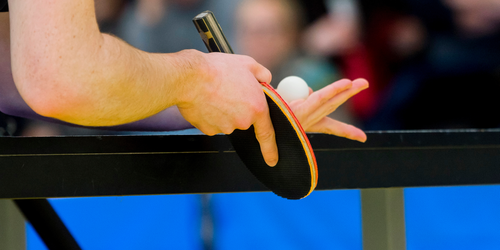Angle and Friction Matter for Table Tennis Spin
The players competing in Sunday’s finals of the World Table Tennis Championship earned their places in the games in part by being able to control the speed and spin of the ball on each return shot. Now Théophile Rémond of the University of Lyon, France, and his colleagues have uncovered the factors that determine a ball’s rotation rate when it rebounds from the table [1]. Spoiler alert: It’s the angle of incidence at which the ball strikes the hard surface and the friction of that surface. Rémond cautions that the study only considers hard surfaces—ones that don’t deform—and so only applies to the ball–table interactions. Interactions between the ball and the paddle—a soft surface—may have other determinant factors.
For their experiments, the team used a spring-loaded system to fire a table tennis ball at a glass plate, varying the angle and speed at which the ball hit. They then used videos of the ball’s interaction with the plate to measure the speed, rotation rate, and angle at which it rebounded.
For incidence angles below 45°, the team observed that on impact, the ball rolled along the surface for a fraction of a full rotation before bouncing off, a sequence of events that set it spinning. For larger incidence angles, the ball slid instead of rolling, decreasing its rebound spin. Looking then at friction, for large angles of incidence, the team found that the magnitude of the spin and speed of the ball were both set during the sliding phase and were dependent on the friction of the glass plate. The parameters both increased with increasing friction saturating at values that were determined by the ball’s rolling motion at small angles of incidence. The team also observed that deformation of the ball upon impact had no significant role on the ball’s rotation rate, which Rémond says is an interesting observation but one he thinks is unlikely to impact the actions of table tennis players.
–Rachel Berkowitz
Rachel Berkowitz is a Corresponding Editor for Physics Magazine based in Vancouver, Canada.
References
- T. Rémond et al., “Oblique impact of a buckling table-tennis ball on a rigid surface,” Phys. Rev. E 107, 055007 (2023).




